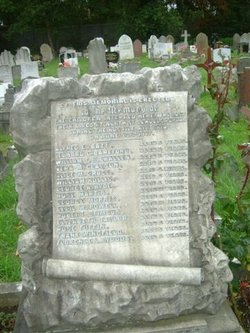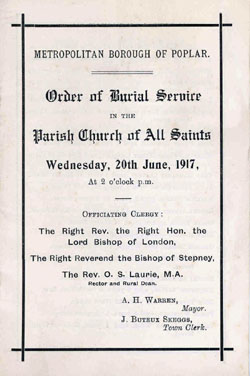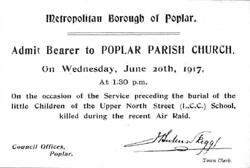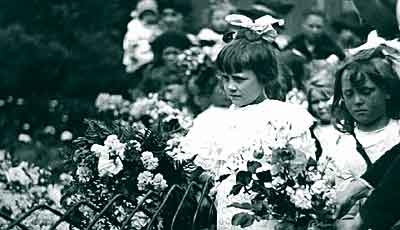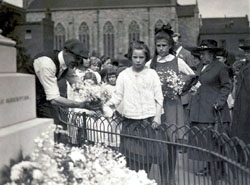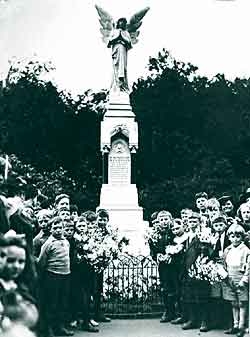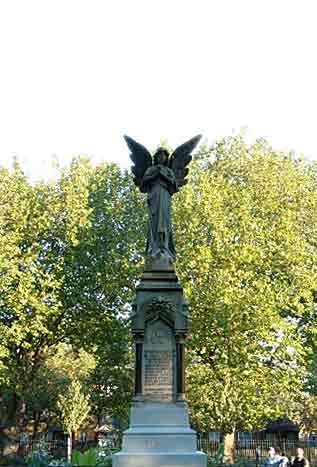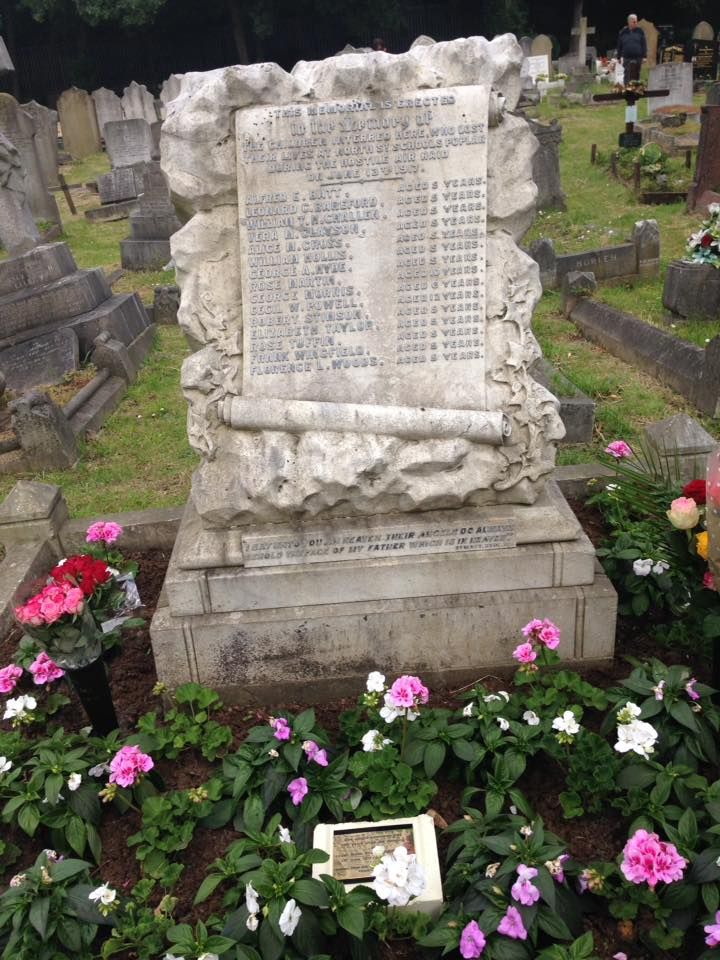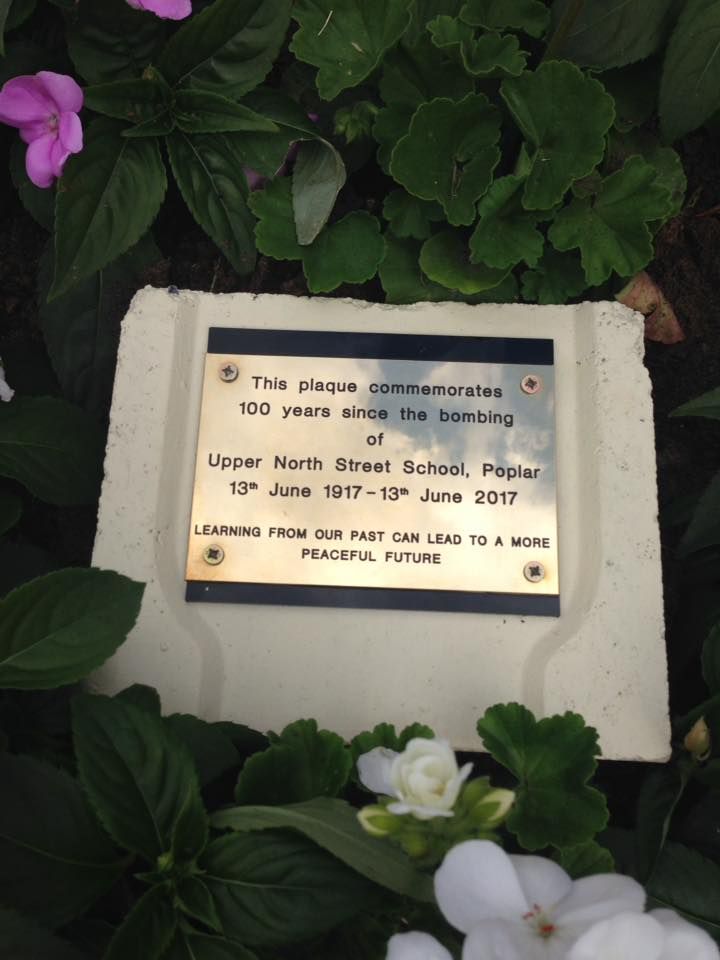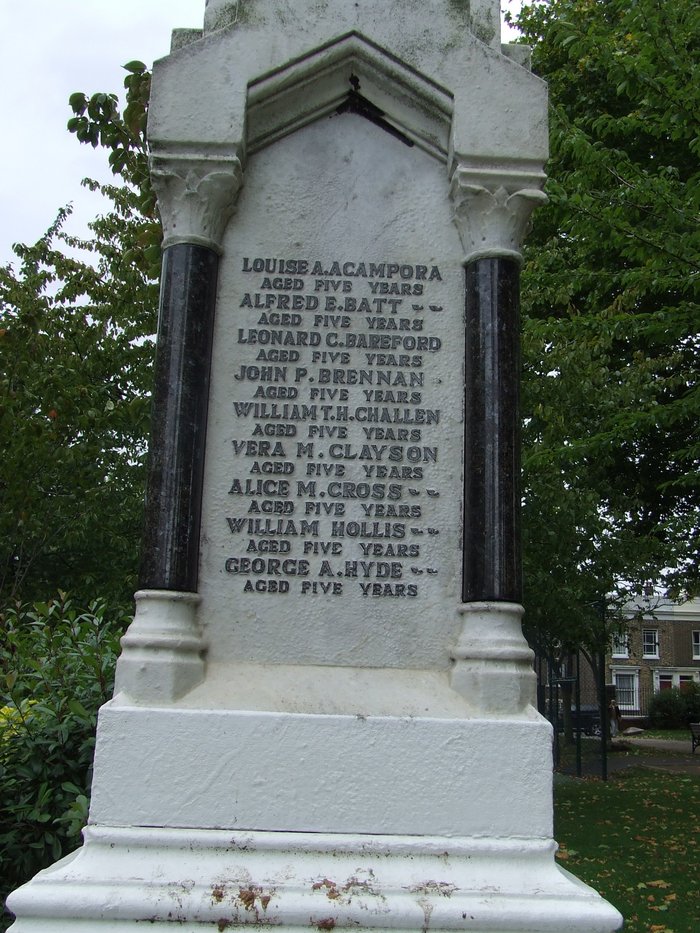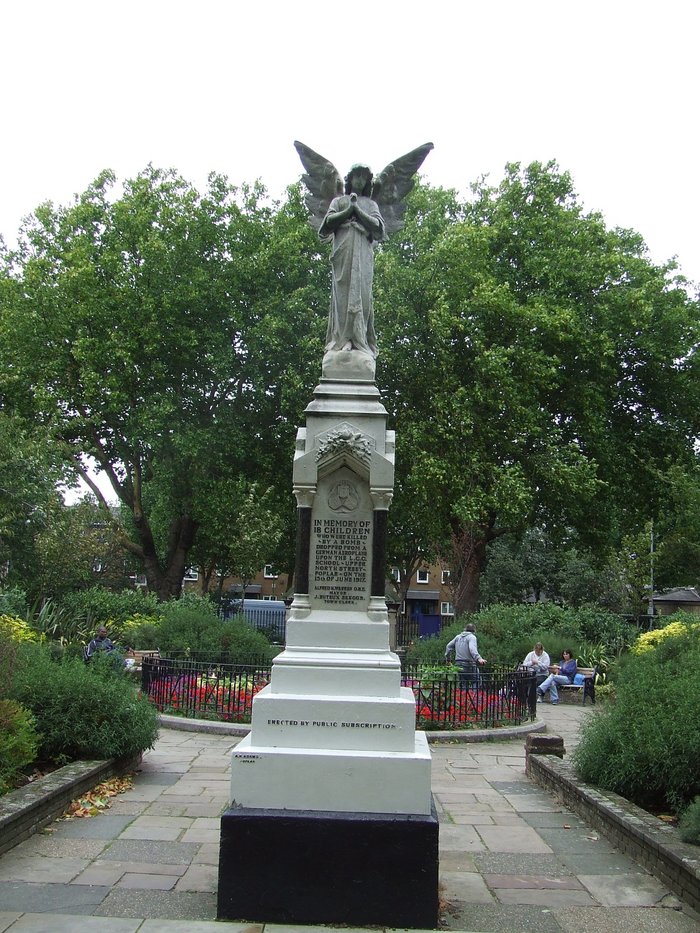The first daylight bombing attack on London by a fixed-wing aircraft took place on 13 June, 1917. Fourteen Gothas led by Squadron Commander Hauptmann Ernst Brandenberg flew over Essex and began dropping their bombs. It was a hot day and the sky was hazy; nevertheless, onlookers in London's East End were able to see 'a dozen or so big aeroplanes scintillating like so many huge silver dragonflies'. These three-seater bombers were carrying shrapnel bombs which were dropped just before noon. Numerous bombs fell in rapid succession in various districts in the East End. In the East End alone; 104 people were killed, 154 seriously injured and 269 slightly injured.
The gravest of incidents that day, was the damage done to a Council school in Poplar. In the Upper North Street School at the time were a girl's class on the top floor, a boy's class on the middle floor and an infant class of about 50 students on the ground floor. The bomb fell through the roof into the girl's class; it then proceeded to fall through the boy's classroom before finally exploding in the infant class.
Eighteen students were killed overall. Sixteen of these were aged from 4 to 6 years old.
Their names and ages are:
LOUISE A. ACOMPORA AGED FIVE YEARS Her full name was Louise Annie Acompora
Daughter of Luigi (Lou)Acompora and Clarissa Emma Acompora
Interred at Leytonstone St Patrick's Cemetery
ALFRED E. BATT AGED FIVE YEARS
LEONARD C. BAREFORD AGED FIVE YEARS
JOHN P. BRENNAN AGED FIVE YEARS -in April 2013, his grave has been located at St Patrick's Cemetery, Leytonstone.
WILLIAM T.H. CHALLIEN AGED FIVE YEARS
VERA M. CLAYSON AGED FIVE YEARS
ALICE M. CROSS AGED FIVE YEARS
WILLIAM HOLLIS AGED FIVE YEARS
GEORGE A. HYDE AGED FIVE YEARS
GRACE JONES AGED FIVE YEARS
[her grave was located at Abney Park Cemetery, London in April 2013]
ROSE MARTIN AGED TEN YEARS
GEORGE MORRIS AGED SIX YEARS
EDWIN C.W. POWELL AGED TWELVE YEARS
ROBERT STIMSON AGED FIVE YEARS
ELIZABETH TAYLOR AGED FIVE YEARS
ROSE TUFFIN AGED FIVE YEARS
FRANK WINGFIELD AGED FIVE YEARS
FLORENCE L. WOODS AGED FIVE YEARS
The two teachers of the infant class acted like heroines as they got everyone out of the building before helping others who were rescuing bodies from the rubble. Panicked mothers searched for their children, desperately hoping they were not one of those caught in the blast. As quickly as possible, the bodies of the children who were killed were removed to the mortuary, and the injured were cared for by nurses and surgeons and taken to the hospitals. The mayor of Poplar at the time, Mr. Will Crooks, expressed his grave sorrow for those affected by the bombing; he said that the children had truly suffered for their country
A week later, on Wednesday 20th June, one of the biggest funerals in London was held for these infants. It was a sad day and a major public event.. Fifteen children were buried in a mass grave at the East London Cemetery, while the other three children had private graves. Brothers and sisters of the children looked on with mournful faces, some having also been in the school at the time of the bombing.
'Signs of sorrow and sympathy were visible throughout the whole of the East End. On every house, blinds were drawn, shutters fixed, and flags had been lowered to half-mast. Preceded by the boys' band of the Poplar Training School, the coffins were borne through vast and silent crowds of people.' The last coffin held unidentified 'broken fragments of little bodies'.
The wreaths, well over 600 of them, excited comment and admiration. They came from local people - individuals, schools, community organisations and institutions - and also from 'the children of Norfolk', New Zealand troops, the 'Kodak Girl' revue company, the Naval Pay Officers Department, Poplar Ambulance Corps, and the Fathers of the Custom House. A local photographer sent a wreath in the shape of a school slate; there were simple bunches of wild flowers; and a galaxy of wreath designs - harps, crosses, broken columns, cushions, anchors, even a shrine.
The funeral service at Poplar Parish Church was conducted by the Bishop of London. Among the mourners were many children, including those who 'had themselves been extricated from the medley of powdered brick, wood and human flesh and blood in their school building after the bomb explosion'.
'When the congregation rose to sing the hymn "There's a Friend for Little Children", few were able to control their voices. One poor girl-mother fainted, but was revived by her husband, whose tender care as he held her in his arms in full view of the congregation showed the depth of his grief - else no Englishman would so far lose his self-consciousness.'
The King had visited the East End immediately after the raid. Now, the Bishop of London read to the congregation a 'simple and sincere' personal message from King George, who, with Queen Mary, was thinking of the children's parents and 'their saddened homes, especially today when the bodies of their little ones are laid to rest'.
'The early ending,' the King's message went on, 'of young innocent lives, at all times pathetic, is made so more than ever in these tragic and cruel circumstances. Their Majesties pray that the mourners may be blessed with God's help and comfort in their sorrow.'
The Mayor of Poplar and Will Crooks, the local MP, headed the raising of a 'convalescents' fund, to send bereaved mothers and traumatised children away for a fortnight's recuperation.
At the beginning of July the first parties - 14 mothers, some with babies, and 70 children from Upper North Street School - set out for 'the beautiful up-river resort of Maidenhead. Women and children appeared delighted at the prospect of a couple of weeks amidst the sylvan charms of Berkshire, away from the din and nerve-trying memories of Poplar. A small party, including the Mayoress, also went to Maidenhead 'to see the mothers and children safely installed in their holiday cottages, and that every comfort conducive to health was provided'.
In addition to the memorial in the cemetery, there are two other known memorials. The first of these is at the site of the tragedy and is listed by the UKNIWM (United Kingdom National Inventory of War Memorials under their reference number UKNIWM Ref: 18052 (UPPER NORTH STREET SCHOOL CHILDREN PLAQUE WW1)
Address: UPPER NORTH STREET SCHOOL
UPPER NORTH ST.
POPLAR
GREATER LONDON
ENGLAND
E14
Type: BOARD/PLAQUE/TABLET
OS Map Ref: TQ 370 800
Inscription
IN MEMORY OF 18 LITTLE CHILDREN KILLED IN THIS SCHOOL BY ENEMY AIRCRAFT ON WEDNESDAY, JUNE 13TH 1917
Beneath the plaque was a framed photograph of the monument over the graves of the victims in the East London Cemetery, and a personal letter from Queen Alexandra.
It was unveiled by MAJ. GEN. E.B. ASHMORE
This was the first ever daylight air-raid. It was also one of the first civilian tragedies of 'total' war; and the deaths of the children in particular caught the public's emotions. A fund was also set up to raise a memorial. It brought in £1,455, 19 shillings and 11 pence: a very large sum for the time. People felt that 'the memorial should also be of such a character as to benefit the living' - so part of the fund was used to endow one bed in the local children's hospital and another in a Hampshire home for crippled children.
The second stands in Poplar Recreation Ground, East India Dock Road . OS Ref TQ377809 . It has Listing Status II, and is under the care of the London Borough of Tower Hamlets. It is built of white Sicilian marble with columns of Labrador granite, in a Victorian Gothic design- a white stone column, tapering upwards from a square base, surmounted by an angel with spread wings, and inscribed with the names of the children who died.
The central part of the column is decorated with marble columns or pillars.It is signed by the local undertaker A. R. Adams.
To this day it arouses emotion in people who stop to look at it.
It was unveiled on June 23, 1919, with appropriate ceremony, to commemorate the children of whom the Mayor of Poplar had said: 'These boys and girls as truly suffered for their country as any men who have perished in the trenches, on the high seas or in the air'.
On south face, below crest of Poplar Borough Council, in embossed lettering:
IN MEMORY OF 18 CHILDREN WHO WERE KILLED ~ BY A BOMB ~ DROPPED FROM A GERMAN AEROPLANE UPON THE L.C.C. SCHOOL ~ UPPER NORTH STREET ~ POPLAR ~ ON THE 13TH OF JUNE 1917.
ALFRED H. WARREN O.B.E. MAYOR.
J. BUTEUX SKEGGS. TOWN CLERK
On the pedestal below:
ERECTED BY PUBLIC SUBSCRIPTION
On west face, excised letters:
LOUISE A. ACOMPORA AGED FIVE YEARS
ALFRED E. BATT AGED FIVE YEARS
LEONARD C. BAREFORD AGED FIVE YEARS
JOHN P. BRENNAN AGED FIVE YEARS
WILLIAM T.H. CHALLIEN AGED FIVE YEARS
VERA M. CLAYSON AGED FIVE YEARS
ALICE M. CROSS AGED FIVE YEARS
WILLIAM HOLLIS AGED FIVE YEARS
GEORGE A. HYDE AGED FIVE YEARS
On east face, excised letters:
GRACE JONES AGED FIVE YEARS
ROSE MARTIN AGED TEN YEARS
GEORGE MORRIS AGED SIX YEARS
EDWIN C.W. POWELL AGED TWELVE YEARS
ROBERT STIMSON AGED FIVE YEARS
ELIZABETH TAYLOR AGED FIVE YEARS
ROSE TUFFIN AGED FIVE YEARS
FRANK WINGFIELD AGED FIVE YEARS
FLORENCE L. WOODS AGED FIVE YEARS
In the top left hand corner of stepped pedestal, incised italic letters : A. R. ADAMS POPLAR
The school caretaker,died on 1st November that year, apparently as a result of shock.He was Benjamin Edwin Batt , aged 31.Benjamin had helped in the search and had carried out the bodies of the children into the play ground after the raid and sadly carried out the body of his own son Alfie.Family history says that the only way he was able to recognise his son was a patch (or button) that had been sown on his trousers that very morning by his wife Alice.
The first daylight bombing attack on London by a fixed-wing aircraft took place on 13 June, 1917. Fourteen Gothas led by Squadron Commander Hauptmann Ernst Brandenberg flew over Essex and began dropping their bombs. It was a hot day and the sky was hazy; nevertheless, onlookers in London's East End were able to see 'a dozen or so big aeroplanes scintillating like so many huge silver dragonflies'. These three-seater bombers were carrying shrapnel bombs which were dropped just before noon. Numerous bombs fell in rapid succession in various districts in the East End. In the East End alone; 104 people were killed, 154 seriously injured and 269 slightly injured.
The gravest of incidents that day, was the damage done to a Council school in Poplar. In the Upper North Street School at the time were a girl's class on the top floor, a boy's class on the middle floor and an infant class of about 50 students on the ground floor. The bomb fell through the roof into the girl's class; it then proceeded to fall through the boy's classroom before finally exploding in the infant class.
Eighteen students were killed overall. Sixteen of these were aged from 4 to 6 years old.
Their names and ages are:
LOUISE A. ACOMPORA AGED FIVE YEARS Her full name was Louise Annie Acompora
Daughter of Luigi (Lou)Acompora and Clarissa Emma Acompora
Interred at Leytonstone St Patrick's Cemetery
ALFRED E. BATT AGED FIVE YEARS
LEONARD C. BAREFORD AGED FIVE YEARS
JOHN P. BRENNAN AGED FIVE YEARS -in April 2013, his grave has been located at St Patrick's Cemetery, Leytonstone.
WILLIAM T.H. CHALLIEN AGED FIVE YEARS
VERA M. CLAYSON AGED FIVE YEARS
ALICE M. CROSS AGED FIVE YEARS
WILLIAM HOLLIS AGED FIVE YEARS
GEORGE A. HYDE AGED FIVE YEARS
GRACE JONES AGED FIVE YEARS
[her grave was located at Abney Park Cemetery, London in April 2013]
ROSE MARTIN AGED TEN YEARS
GEORGE MORRIS AGED SIX YEARS
EDWIN C.W. POWELL AGED TWELVE YEARS
ROBERT STIMSON AGED FIVE YEARS
ELIZABETH TAYLOR AGED FIVE YEARS
ROSE TUFFIN AGED FIVE YEARS
FRANK WINGFIELD AGED FIVE YEARS
FLORENCE L. WOODS AGED FIVE YEARS
The two teachers of the infant class acted like heroines as they got everyone out of the building before helping others who were rescuing bodies from the rubble. Panicked mothers searched for their children, desperately hoping they were not one of those caught in the blast. As quickly as possible, the bodies of the children who were killed were removed to the mortuary, and the injured were cared for by nurses and surgeons and taken to the hospitals. The mayor of Poplar at the time, Mr. Will Crooks, expressed his grave sorrow for those affected by the bombing; he said that the children had truly suffered for their country
A week later, on Wednesday 20th June, one of the biggest funerals in London was held for these infants. It was a sad day and a major public event.. Fifteen children were buried in a mass grave at the East London Cemetery, while the other three children had private graves. Brothers and sisters of the children looked on with mournful faces, some having also been in the school at the time of the bombing.
'Signs of sorrow and sympathy were visible throughout the whole of the East End. On every house, blinds were drawn, shutters fixed, and flags had been lowered to half-mast. Preceded by the boys' band of the Poplar Training School, the coffins were borne through vast and silent crowds of people.' The last coffin held unidentified 'broken fragments of little bodies'.
The wreaths, well over 600 of them, excited comment and admiration. They came from local people - individuals, schools, community organisations and institutions - and also from 'the children of Norfolk', New Zealand troops, the 'Kodak Girl' revue company, the Naval Pay Officers Department, Poplar Ambulance Corps, and the Fathers of the Custom House. A local photographer sent a wreath in the shape of a school slate; there were simple bunches of wild flowers; and a galaxy of wreath designs - harps, crosses, broken columns, cushions, anchors, even a shrine.
The funeral service at Poplar Parish Church was conducted by the Bishop of London. Among the mourners were many children, including those who 'had themselves been extricated from the medley of powdered brick, wood and human flesh and blood in their school building after the bomb explosion'.
'When the congregation rose to sing the hymn "There's a Friend for Little Children", few were able to control their voices. One poor girl-mother fainted, but was revived by her husband, whose tender care as he held her in his arms in full view of the congregation showed the depth of his grief - else no Englishman would so far lose his self-consciousness.'
The King had visited the East End immediately after the raid. Now, the Bishop of London read to the congregation a 'simple and sincere' personal message from King George, who, with Queen Mary, was thinking of the children's parents and 'their saddened homes, especially today when the bodies of their little ones are laid to rest'.
'The early ending,' the King's message went on, 'of young innocent lives, at all times pathetic, is made so more than ever in these tragic and cruel circumstances. Their Majesties pray that the mourners may be blessed with God's help and comfort in their sorrow.'
The Mayor of Poplar and Will Crooks, the local MP, headed the raising of a 'convalescents' fund, to send bereaved mothers and traumatised children away for a fortnight's recuperation.
At the beginning of July the first parties - 14 mothers, some with babies, and 70 children from Upper North Street School - set out for 'the beautiful up-river resort of Maidenhead. Women and children appeared delighted at the prospect of a couple of weeks amidst the sylvan charms of Berkshire, away from the din and nerve-trying memories of Poplar. A small party, including the Mayoress, also went to Maidenhead 'to see the mothers and children safely installed in their holiday cottages, and that every comfort conducive to health was provided'.
In addition to the memorial in the cemetery, there are two other known memorials. The first of these is at the site of the tragedy and is listed by the UKNIWM (United Kingdom National Inventory of War Memorials under their reference number UKNIWM Ref: 18052 (UPPER NORTH STREET SCHOOL CHILDREN PLAQUE WW1)
Address: UPPER NORTH STREET SCHOOL
UPPER NORTH ST.
POPLAR
GREATER LONDON
ENGLAND
E14
Type: BOARD/PLAQUE/TABLET
OS Map Ref: TQ 370 800
Inscription
IN MEMORY OF 18 LITTLE CHILDREN KILLED IN THIS SCHOOL BY ENEMY AIRCRAFT ON WEDNESDAY, JUNE 13TH 1917
Beneath the plaque was a framed photograph of the monument over the graves of the victims in the East London Cemetery, and a personal letter from Queen Alexandra.
It was unveiled by MAJ. GEN. E.B. ASHMORE
This was the first ever daylight air-raid. It was also one of the first civilian tragedies of 'total' war; and the deaths of the children in particular caught the public's emotions. A fund was also set up to raise a memorial. It brought in £1,455, 19 shillings and 11 pence: a very large sum for the time. People felt that 'the memorial should also be of such a character as to benefit the living' - so part of the fund was used to endow one bed in the local children's hospital and another in a Hampshire home for crippled children.
The second stands in Poplar Recreation Ground, East India Dock Road . OS Ref TQ377809 . It has Listing Status II, and is under the care of the London Borough of Tower Hamlets. It is built of white Sicilian marble with columns of Labrador granite, in a Victorian Gothic design- a white stone column, tapering upwards from a square base, surmounted by an angel with spread wings, and inscribed with the names of the children who died.
The central part of the column is decorated with marble columns or pillars.It is signed by the local undertaker A. R. Adams.
To this day it arouses emotion in people who stop to look at it.
It was unveiled on June 23, 1919, with appropriate ceremony, to commemorate the children of whom the Mayor of Poplar had said: 'These boys and girls as truly suffered for their country as any men who have perished in the trenches, on the high seas or in the air'.
On south face, below crest of Poplar Borough Council, in embossed lettering:
IN MEMORY OF 18 CHILDREN WHO WERE KILLED ~ BY A BOMB ~ DROPPED FROM A GERMAN AEROPLANE UPON THE L.C.C. SCHOOL ~ UPPER NORTH STREET ~ POPLAR ~ ON THE 13TH OF JUNE 1917.
ALFRED H. WARREN O.B.E. MAYOR.
J. BUTEUX SKEGGS. TOWN CLERK
On the pedestal below:
ERECTED BY PUBLIC SUBSCRIPTION
On west face, excised letters:
LOUISE A. ACOMPORA AGED FIVE YEARS
ALFRED E. BATT AGED FIVE YEARS
LEONARD C. BAREFORD AGED FIVE YEARS
JOHN P. BRENNAN AGED FIVE YEARS
WILLIAM T.H. CHALLIEN AGED FIVE YEARS
VERA M. CLAYSON AGED FIVE YEARS
ALICE M. CROSS AGED FIVE YEARS
WILLIAM HOLLIS AGED FIVE YEARS
GEORGE A. HYDE AGED FIVE YEARS
On east face, excised letters:
GRACE JONES AGED FIVE YEARS
ROSE MARTIN AGED TEN YEARS
GEORGE MORRIS AGED SIX YEARS
EDWIN C.W. POWELL AGED TWELVE YEARS
ROBERT STIMSON AGED FIVE YEARS
ELIZABETH TAYLOR AGED FIVE YEARS
ROSE TUFFIN AGED FIVE YEARS
FRANK WINGFIELD AGED FIVE YEARS
FLORENCE L. WOODS AGED FIVE YEARS
In the top left hand corner of stepped pedestal, incised italic letters : A. R. ADAMS POPLAR
The school caretaker,died on 1st November that year, apparently as a result of shock.He was Benjamin Edwin Batt , aged 31.Benjamin had helped in the search and had carried out the bodies of the children into the play ground after the raid and sadly carried out the body of his own son Alfie.Family history says that the only way he was able to recognise his son was a patch (or button) that had been sown on his trousers that very morning by his wife Alice.
